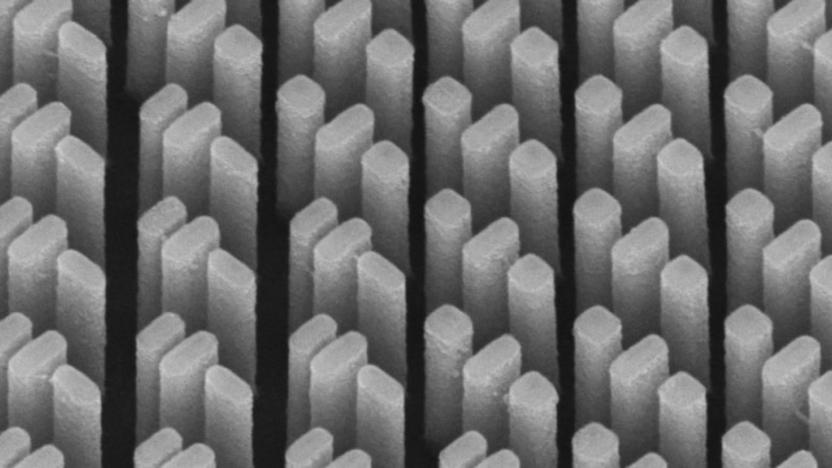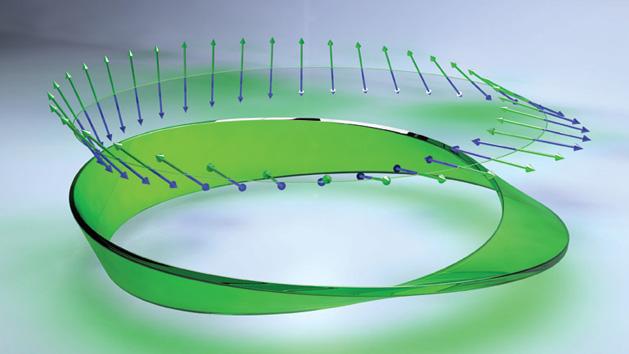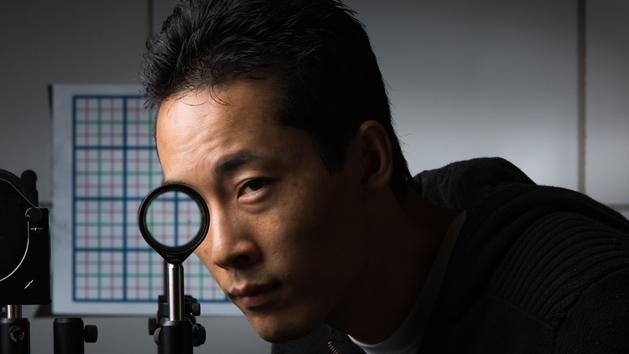optical
Latest

CommStar will launch a relay satellite to talk to astronauts on the Moon
CommStar Space Communications plans to launch a data relay satellite that will serve as communications infrastructure for government and commercial space ventures.

Breakthrough searches for signs of alien life in ultra-fast light pulses
Internet investor Yuri Milner's search for extraterrestrial life now includes a hunt for, effectively, interstellar Morse code. Breakthrough Listen is teaming with the partners behind VERITAS (the Very Energetic Radiation Imaging Telescope Array System) to search for nanoseconds-long optical pulses that could indicate the presence of aliens trying to flash messages across the cosmos. The collaboration will use all four telescopes at once to check for these light-based "beacons," which would could be brighter than stars observed in the same direction.

Researchers find a way to fix the purple halo effect in images
While cameras and cutting-edge microscopes have come on leaps and bounds in recent years, the optical technology these kind of products use hasn't really changed since the mid-1700s. Even the highest spec gear relies on compound lenses, which were invented around 1730. Their main function is to bring together different wavelengths of light that otherwise focus in different spots. This corrects what's called "chromatic aberrations," or in other words, the purple halo that appears in images when the wavelengths are focused at different points. The problem is, these lenses are bulky, expensive and not as effective as they could be. But researchers at Harvard have found a solution with its newly-developed "metacorrector".

IBM built a handheld counterfeit goods detector
Just a month after IBM announced it's leveraging the blockchain to guarantee the provenance of diamonds, the company has revealed new AI-based technology that aims to tackle the issue of counterfeiting -- a problem that costs $1.2 trillion globally. IBM Crypto Anchor Verifier brings together AI and optical imaging to help prove the identity and authenticity of frequently forged goods such as fine wine, diamonds and medicine, as well as analyze water quality and detect bacteria, such as E.coli. And the technology is small enough to use with a cell phone camera.

ESA plans to measure ocean plastic data from space
Scientists at the European Space Agency (ESA) are working on a technology that would allow them to identify from space just how much plastic there is floating around in oceans. Until now, researchers have used satellite maps to simulate the accumulation of marine trash, but the new project would use direct optical measurements to provide actual data on the scale of the issue.

SteelSeries says it’s nailed 'true 1-to-1' mouse tracking
Gaming peripheral brand SteelSeries has expanded its mouse lineup with an offering that could prove to be the Holy Grail for serious esports gamers: true "1-to-1" tracking. The company's new TrueMove3 sensor means your mouse movement will match up exactly with movement on-screen, regardless of the CPI setting (counts per inch, or the number of pixels your mouse moves in a single inch). Engineered in partnership with PixArt -- the team behind the Wii Remote -- the sensor is the product of the company's 15-year quest to make the perfect gaming mouse and is available exclusively in the newly-designed Sensei 310 and Rival 310 models.

Smallest-ever optical switch revolves around one atom
We've seen some ridiculously tiny electronics in our day, but this might take the cake. Swiss researchers have built an optical networking switch so small that it's measured on the atomic scale -- in fact, it's smaller than the wavelength of light it needs to transmit data. The system can use just one silver atom to transmit an electrical current between silver and platinum pads. Apply enough voltage and the atom moves into place; stop and the atom shies away. Surprisingly simple, isn't it?

Optical nanotech sensor can sniff out bad food and explosives
The days of having to rely on pricey lab sensors (or carefully trained canines) to detect bad food and bombs may soon come to an end. Oregon State University researchers have developed a hybrid optical and nanotechnology sensor that's at once super-sensitive to gas, but won't weigh a ton or cost a fortune. It uses a super-thin, metal-organic film to absorb the gas, and magnifies the telltale chemical signals using low-cost plasmonic nanocrystals that act like miniature optical lenses. It's best-suited to watching out for carbon dioxide (helpful for businesses that want to fight greenhouse gases), but it can detect a "wide range" of materials.

Scientists make a Mobius strip of laser light
Unless you count incidents in Star Trek episodes, Möbius strips don't really occur in nature -- you have to create that freaky one-sided shape yourself. However, a worldwide team of scientists may have produced the next best thing. They've created a Möbius strip of light by manipulating the polarization of the light's inherent electromagnetic field. The trick involves firing a highly focused laser beam through a liquid crystal lens to give it a very specific polarization. When the light scatters at the focal point with the help of a nanoparticle, that polarization creates tiny, twisted loops. While these strips were made in a lab, of course, the experiment shows that they're at least possible in nature.

Light-bending silicon strips are the key to super-fast computers
No, that's not a barcode you're looking at -- instead, it's the likely future of computing. Stanford University researchers have developed an optical link that uses silicon strips to bend light at right angles, which future processors will likely need to transmit data at super-fast speeds. The key, as you might have gathered, is the series of gaps. When light hits the device, the combination of those gaps and silicon sends different wavelengths left and right. You're not limited to specific light bands or directions, either; you can use an algorithm to design the link you need within a matter of minutes.

Scientists make an invisibility cloak using off-the-shelf optical lenses
Most invisibility cloaks require fairly exotic technology to work, such as fiber optics or light-altering metamaterials. That's not very practical, especially since the illusion still tends to break when you move. The University of Rochester may have a far more realistic solution, however -- it has developed a cloak that only needs run of the mill optical lenses to hide objects from view. The system really boils down to clever math. By positioning two pairs of lenses in the right order, researchers can bend light in a way that hides almost everything you put in the middle of this arrangement. The approach scales up with the size of the glass, and it works at angles of 15 degrees or more; you don't need to look head-on to see the effect.

Desktop-sized laser supercomputers could be coming by 2020
Small, eco-friendly optical supercomputers may soon be crunching quadrillions of calculations per second (exaflops) if a company called Optalysys has its way. It claims to be months away from demonstrating a prototype optical computer that will run at 346 gigaflops to start with -- not as fast as the best supercomputers, but pretty good for a proof-of-concept. Here's how it works: low-intensity lasers are beamed through layers of liquid crystal grids, which change the light intensity based on user inputted data. The resulting interference patterns can be used to solve mathematical equations and perform other tasks. By splitting the beam through multiple grids, the system can compute in parallel much more efficiently than standard multi-processing supercomputers (as shown in the charming Heinz Wolff-hosted video below).

Future phones will have security measures built into the glass
The glass on your smartphone screen doesn't do a lot right now: it lets pictures and touch input get through, and that's about it. It may pick up a few extra talents in the future, though. Researchers at Polytechnique Montreal have developed sensors that can sit under the surface of the scratch-resistant Gorilla Glass used in many mobile devices. Their approach etches optical waveguides into the display, letting it track changes in light. As a result, the screen can do things that would normally require either wiring or dedicated sensors. Your phone could check its temperature using light, and the manufacturer could even embed a unique optical pattern into the glass that lets the phone identify itself; it might get much harder to clone a device (and, presumably, its information).

Intel teases MXC: a 1.6Tbps optical interconnect for servers
While we think of optical connections as cutting edge, they're positively decrepit in server rooms; current fiber interconnect technology got its start in the 1980s. Intel may soon drag servers into the modern era with its just-teased MXC format, however. The standard (not pictured here) will combine both silicon photonics and a new form of Corning fiber to link servers at 1.6Tbps -- more than quick enough to eliminate many data bottlenecks. The connectors themselves are smaller, too. Intel won't say more about MXC until the Intel Developer Forum next month in San Francisco, but we already suspect that supercomputer operators will be happy with all that extra bandwidth.

Sony and Panasonic ally to launch next-generation 300GB optical discs
During the heyday of optical storage we saw a 400GB Blu-Ray flavor (shown above) and even 1TB discs in the lab, but lately such development has waned. Sony and Panasonic have teamed up to move things along, however, saying there's a need for reliable long-term storage that only optical disks can provide. The pair will develop a "next-generation standard for professional-use optical discs," saying that a 300GB flavor could be ready in two years or so. Though geared towards industries like cloud storage and digital cinema at first, the tech could eventually trickle down to consumers, too. Given rapid developments in on-demand streaming and cloud gaming, however, there might be nothing left for us plebes to archive by then.

Fiber optic Thunderbolt cables coming soon
Sumitomo Electric Industries has announced that it's the first company to receive certification from Intel to produce optical Thunderbolt cables. Currently all Thunderbolt cables have metal components, which limit the maximum length of those cables to around 10 feet. Optical Thunderbolt cables will allow lengths of up to 100 feet, which will be helpful in professional post-production studios, especially as noisy hard drives or other accessories can be kept away from sensitive audio recording equipment. Sumitomo Electric says the new cables will provide the full 10 Gbps of the metal cables, and can become tangled or pinched up to 180 degrees without seeing any kind of signal degradation. The optical cables will be as thin as the current metal Thunderbolt cables, but their connection heads will be slightly longer at 38mm versus the metal cable's 28mm connection. One other difference is that optical cables are not capable of powering devices, like external hard drives. Any bus-powered devices will need a separate power supply to run when connected via an optical Thunderbolt cable. The new optical Thunderbolt cables will be compatible with all Macs and devices shipped with Thunderbolt ports to date. Sumitomo Electric Industries has not announced any pricing yet.

Nokia Siemens Networks sells off its optical business, swings focus to LTE
Nokia Siemens Networks has long been eager to shed as much weight as it can (unfortunately, including some staff) in a bid to turn around a business full of legacy hardware. The next on the chopping block, however, is a big one: the optical networking division. NSN has struck a deal to sell the fiber-focused group to Marlin Equity Partners and spin it out as a separate company. While the price of the deal isn't public, we're glad to hear that the 1,900 workers affected by the shift should keep their jobs if the agreement closes as promised, in early 2013. NSN chief Rajeev Suri makes no bones about the handover's goal -- it's to let his company concentrate on LTE and other thriving businesses while giving the optical group a second chance through Marlin's investment, if all goes well. We're left with an NSN that's considerably smaller than what we knew from its glory days, but it could be worth the hurt pride if the company stays standing.

Parrot Zikmu Solo reaches US in November, makes a tower of wireless sound yours for $999
Parrot has taken some time trotting out the Zikmu Solo speaker since we first saw it at CES, but those enamored with very vertical audio can rest easy now that the unit has a North American release schedule. Both Canada and the US can buy the Philippe Starck-crafted speaker in November, when it will cost $999 for Americans in its black and white guises (sorry, no red for now). While that's a lot to pay for a 100W speaker, Parrot is counting on the unique acoustic design, a conventional iOS dock and a mix of Bluetooth, NFC and WiFi to tempt people away from the land of horizontal sound. It's undoubtedly one of the easiest ways to make a speaker dock the focus of a room -- and that's part of the point, isn't it?

iPhone 5 and Nokia Lumia 920 face off with image stabilization test (hands-on video, updated with Galaxy S III and HTC One X)
Nokia's Lumia 920 packs the industry's best image stabilization -- there's no questioning that -- thanks to a camera module that pairs both sensor and lens-based optical IS. The iPhone 5 also offers a notable improvement over its Apple-made predecessor on the video front, but considering that its stabilization is of the digital variety, we wouldn't expect it to top Nokia's new flagship. We had an opportunity to test both smartphones in a head-to-head demo at Nokia's research and development facility in Tampere, Finland, about two hours north of the company's Espoo headquarters. In fact, we're told that this is the very first such comparison shoot in the world, considering that the iPhone made it to market just last week and the only opportunity to shoot with a Lumia 920 is currently in the European country where the device was born. As expected, the Nokia phone was able to capture far smoother video than what we snapped with the iPhone, with both devices secured side-by-side in a homemade foam holster. Unlike our handheld interview shoot earlier today, we pushed the limits a bit further this time, running through Nokia's parking lot and turning every which way as well. It's important to note that the Lumia 920 we used was a prototype, but its performance was still quite solid. You'll find the side-by-side video just past the break -- the Lumia 920 is on the left, with the iPhone clip on the right.

Attention world: the MacBook Pro with Retina display does have optical audio out
Please stop saying it doesn't. Despite it not appearing on Apple's specs page, there is no conspiracy, and Apple hasn't dropped the feature. The MacBook Pro with Retina display has the same combination 3.5mm-analog-and-S/PDIF-digital output port all other Macs have used for several years now. Thanks to TUAW reader Patrick Perini (and his shiny new MacBook Pro, iCarus) for sending us the screenshot above, and to the Guardian's Charles Arthur for also confirming this to be true.





